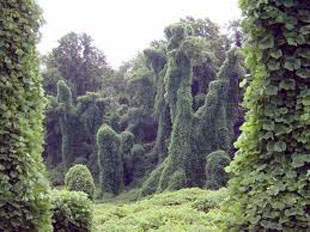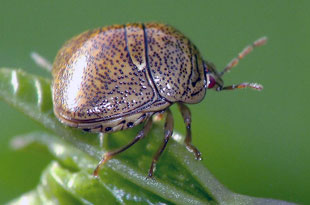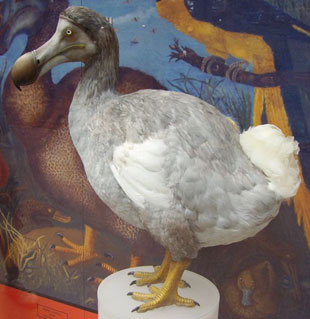
Today the lower forty, tomorrow the world . . .
When I was a child in Montgomery, Alabama, during the very early sixties, I can remember certain areas around town that spent much of the year buried under a green and hairy shroud that covered telephone poles, buildings, billboards, trees, parked cars, slow-moving pedestrians: the dreaded kudzu.
Kudzu (several species of the genus Pueraria) wasn’t always the enemy: native to eastern Asia, it was brought to Philadelphia in 1876 as a fast-growing ornamental vine. Limited by the cold winters of the Northeast, the plant seemed harmless, even useful, providing a lush canopy of green shade for arbors and porches in a fraction of the time required by wisteria or grapes. In the South it helped stabilize slopes and replenish soil nitrogen. During the Great Depression the Soil Erosion Service of the USDA distributed 85 million seedlings to be grown for erosion control and livestock feed. Kudzu was our friend.
“There was an old lady who swallowed a fly
From a song with music by Alan Mills and lyrics by Rose Bonne.
I don’t know why she swallowed a fly –
perhaps she’ll die!
There was an old lady who swallowed a spider,
That wriggled and wiggled and tiggled inside her;
She swallowed the spider to catch the fly;
I don’t know why she swallowed a fly –
Perhaps she’ll die!”
Then, suddenly, another out-of-town guest appeared, jumping the Texas border in the late 1800’s, and exploding into infamy in the 1920’s: Anthonomus grandis, the boll weevil. Cotton farmers throughout the Deep South were driven off their land as their crops were ravaged beyond salvage. Selling out and moving into the cities, they abandoned homesteads and farms — leaving behind plantings of kudzu that had shaded porches or anchored hillsides from Shreveport to Savannah. By 1953 the USDA had begun to grow uneasy about the ever-enlarging mounds of vegetation, and removed kudzu from its list of recommended ground covers. By 1970, there was nothing left to do but move the women and children to high ground and start praying.
In the heat and humidity of places like Montgomery, Alabama, or Tupelo, Mississippi, kudzu will grow at a rate of 12 inches per day. A lawnmower left unattended will disappear in a week; a parked car in ten days; a small house will vanish in two months.

It’s small, it’s ugly, and it smells really bad. Can it save the South?
Fast-forward to the end of the first decade of the 21st Century: another (yes, another) insect has appeared on the local scene, this time from China and India: Megacopta cribraria, the Bean Plataspid, the Lablab Bug, or, more commonly, the kudzu bug. Kudzu bugs are tiny round insects that suck the vital juices from beans, wisteria, soy, and — the silver lining? — kudzu. Kudzu bugs love white surfaces, for some reason, and have spread throughout much of the Southeastern US riding on white cars and trucks. They are more effective at controlling kudzu than herbicides, less labor-intensive than mowing and cutting — and, perhaps most convincing of all, they are already here.
Unfortunately, soybeans are a major crop in many parts of the South, and soybean farmers don’t view the kudzu bug in such a positive light. Debate rages between farmers facing yet another insect threat to their crops and suburbanites who can’t locate their garages from May to November about whether to encourage the spread of the kudzu bug as a possible means to fight back against the green invader.
The argument is probably academic, of course, since the creature is here, and probably won’t just get bored and leave any time soon. We’ve swallowed the spider to catch the fly, and there is no going back.
Horses originally evolved in North America from small, rabbity ancestors that appeared after the demise of the great dinosaurs. They spread and diversified for millions of years, finally developing into the beasts that we know today, the genus Equus, about three and a half million years ago, spreading from North America into Asia, then onward to Africa. Approximately 12,000 years ago, however, the horse completely disappeared from North America, the land of its birth, driven to extinction by factors such as climate change, as the advancing ice turned grasslands and prairies into tundra, and the arrival from Asia of human hunters.
Then, in 1538, Hernán Cortés brought sixteen horses to Florida, the first of many introduced by the Spanish explorers, and equine hooves once again pounded North American prairies, brought back by the very same predator that had contributed to their disappearance all those millennia before.
Underneath our settled veneer, humans are nomads: there have always been those who travel, seeking trade or adventure or fleeing from persecution or punishment. We look for something new, something better, something different — all the while bringing with us the comfortable, the trusted, and the familiar. The Mongols and Turks brought garlic and tulips from their barren, windswept homes in Central Asia to the riverbanks and villages of Europe. Pigs and rats came with the trading ships to Mauritius and promptly wiped out the dodo. Honeysuckle and privet have long since come to be synonymous with summer in the Deep South, even though both plants are, like kudzu, imports from Asia. Smallpox came to North America from Europe and wiped out entire populations, while syphilis was sent back to return the favor.

Raphus cucullatus: First, it was in the wrong place at the wrong time. Then, it just wasn’t anywhere at all.
Even without humans in the equation, few ecosystems are completely closed; ocean breezes blow pollen, seeds, and insects from one island to another; storms carry birds off course; drought or floods drive animals from familiar pastures into new territories. Humans have simply taken the process a step further, intentionally carrying our food animals and plants from place to place, unintentionally bringing our pests and parasites along for the ride.
This inevitability does not absolve us of responsibility for the systems we disrupt, nor does it protect us from the crises we bring upon ourselves. We are a source for diversity and devastation, forcing native populations to adapt to new threats, and protecting threatened populations from change too rapid to accommodate. Roughly one-fourth of all plant and animal species are facing extinction today, in a majority of cases due either directly or indirectly to human activity. There have been several previous extinction episodes in Earth’s history, some more severe, some less, but none have operated on such an accelerated timescale: changes to climate and to plant or animal species that in the past took from tens of thousands of years to tens of millions, are occurring today in a span of decades; these changes are happening too fast for plants and animals to adapt, to migrate, or to acclimate themselves. Instead, like the aurochs — the wild ox of the Bible — and the passenger pigeon — the most common bird in North America when the Declaration of Independence was signed — more and more organisms are simply dying out, leaving behind bleeding wounds in ecosystems that are already under stress.
In the nineteenth century whalers and traders brought rats to the Pacific island of Guam, where the rodents proceeded to decimate the local ecology. Eventually, in an effort to control the rats, someone brought snakes to the island. The snakes devoured the rats, bringing down their numbers, but proliferated wildly in the process; when the rats began to thin out, the snakes turned to the native birds for food. Today, mongooses are being brought in from India in an effort to control the snakes.
We can’t put the genie back into the bottle, the toothpaste back into the tube — once we’ve swallowed the fly we have to move forward, we have to decide what we’re going to do, how we’re going to address the situation. Ideology, in the end, is irrelevant. We can only try to look ahead at the outcomes of our actions before we take them, and make those considerations part of the process. We will do what we feel we have to do — or what we feel we’re entitled to do — but there will always be consequences. Pretending otherwise is not only foolish, it can be fatal.
The little old lady who swallowed the fly never really solves her problem. In the end, after a long series of ever more unlikely and desperate efforts to regain control of the situation, she dies. She might have better off being more careful in the first place.
* * *
Leave a Reply